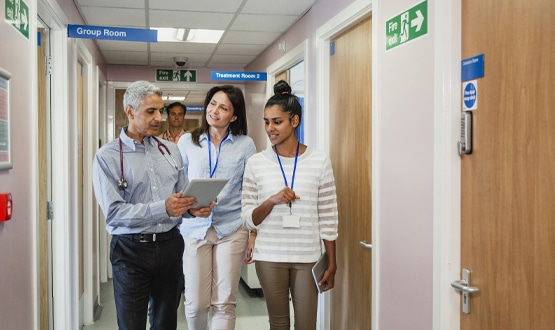How CfH could make my day
- 2 September 2008
 |
| Dr Neil Paul |
The ‘nudge’ method of influencing people is a new economic theory that looks at how to convince people to do something – not by using a carrot and stick, but by taking a more subtle approach that plays to human behaviour.
An example would be using white lines on a road; painting them closer together makes you feel you that you should slow down as you approach a roundabout. Another would be having a read-out in the kitchen or living room showing you how much electricity you are using; the jump every time you turn something on would persuade you to use less.
I was fascinated when I heard a guru asked on the radio how he would stop people eating too much. Would he fine people for throwing things out or tax food more so that we would eat less? He said no; he would set a maximum size of plate that could be sold.
I wonder if Connecting for Health (CfH) could use some of these techniques, as most of what they have done so far to get people to use their stuff seems to have had the opposite effect.
Choose and Book is such a dreadful user experience that I don’t want to use it; and having to use a smartcard just slows everything down, so I have disabled it on my computer. But short of rebuilding its core systems, there are several things that CfH could do to improve our lives, gain it good PR, and make us more inclined to use its systems.
First, passwords. Why do we have so many? And why do different systems have their own password rules? Some passwords are case sensitive, some aren’t; some are PINs, some are words; some change monthly, some yearly. Sometimes, you don’t have to use a password at all.
In the real world, a lot of websites allow you to use a single user logon through a system like Microsoft’s passport or Google’s user account. Why can’t medical software do the same?
It’s not like we don’t have some options. Most people I know log on to Windows using domain level security; why can’t this be the single log on for everything? Or, a complete fortune was spent upgrading every keyboard in the country to work with a smartcard reader; so why can’t we use them for everything?
Personally, I think it would have been better to use finger print recognition. That way, nobody would have the nightmare of keeping cards up to date, reissuing them when they are lost or stolen, or finding a work around when they are forgotten. It would also stop people leaving them in the reader at all times.
I know some work has been done on this, but there has not been enough, especially in primary care. If this could be sorted out it would generate great positive feeling. It would also “nudge” everyone into properly logging on to everything, so we had proper access controls and audit trails.
Next, I hope that the next big buzz phrase is going to be “single inbox.” I have heard numerous managers whinge about emails and calendars – and my exposure to PCT-land has shown me that they have a point. Recently, I was triple booked for three meetings in three different buildings.
However, my multiple inboxes trump any manager’s problems. I have my Exchange inbox, my nhs.net inbox and my home email inbox. Then I have my Docman inbox for letters, my Frontdesk inbox for messages, my Emis email inbox, my Emis practice notes inbox, my blood and pathology results inbox and my medication requests inbox.
I could also check the GP2GP inbox and out of hours inbox – but I leave these to administrators and we let our secretaries check our Choose and Book inboxes for rejections. (Did I mention I don’t use my smartcard?!)
Also, receptionists often leave messages on my appointments screen – usually asking me to check a specific inbox urgently. And there are Emis screen messages and Frontdesk screen messages that can pop up at any moment.
Why can’t I have one master program that shows me how many messages I have in all of these areas and their priorities, so I can manage them better? I don’t think this is impossible. Perhaps Microsoft could have a go as part of its Common User Interface programme? Making clinicians more productive should be a big goal; we would have more time to spend with patients.
Dr Paul is a GP in Sandbach, Cheshire and a member of the professional executive committee for Central and East Cheshire PCT and has a lead role for IM&T and practice based commissioning. A version of this article first appeared on the Microsoft NHS Resource Centre.




